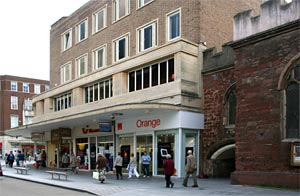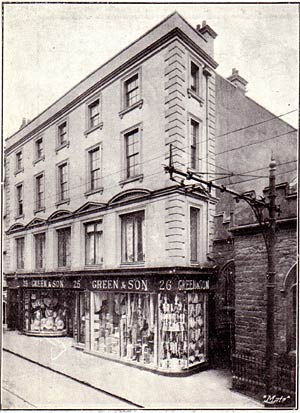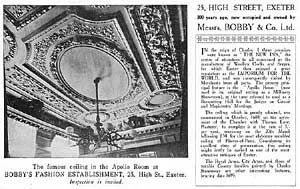
- Home
- Memories
- Scrapbook ▽
- Topics ▽
- People ▽
- Events
- Photos
- Site Map
- Timeline
Return to Pub List
In May 1942, the department store, Bobby's was destroyed by fire and bomb. In one night, the last of a building that dated back to the 15th Century was lost, to be replaced by a 1950's brick built, block of shops - Thomson Travel and the Orange Mobile Shop now occupy the site.
The New Inn was first mentioned in a 1456 document regarding the lease of shops in the High Street "opposite 'Le Newe Inne' in the Parish of St. Stephen". The New Inn was appropriately, newly built on land that belonged to the Chapter and the Chamber (the Cathedral and the City). The inn was long a point of issue between the Cathedral and City for its encroachment onto city land. Again in 1447 the inn was mentioned, this time when its own lease was renewed for a tenant by the Dean & Chapter for 56 years at a rent of £5.
Over the years, the inn was remodelled and its rooms adapted for various uses. In 1554, the City resolved to move the Cloth Hall established at the Eagle or le Egle, opposite the Guildhall to the New Inn. It was established in 1555 when it was described as "..a commodious hall for all manner of clothe, Lynnen or wollyn, and for all other m'chandises and w ch shalbe called the m'chants hall."
The New Inn continued to be run as an inn under the stewardship of a succession of innkeepers, some good, some bad, as documented by the city records. After 1612, the New Inne Halle or Merchant Hall was let separately from the New Inn as an Exchange for cloth merchants - the merchants rented stalls in the hall to conduct their trade.
In 1626, there was an account by Thomas Flay, Receiver of the City, in which the county magistrates are said to hold their sittings at the New Inn. The Exeter Mercury in January 1716 carried a notice that the New Inn, currently in the possession of Benjamin Johnson is to be let for 7 or 14 years from Michaelmas.
Work on the famous Apollo Room, which survived until 1942, was started during the Civil War - its handsome ceiling dated from 1689, being a prime example of the work of the Devonian Thomas Lane, who was paid five shillings per yard, or a total of £50. It measured 10 metres by 7 metres wide and there were various coats of arms painted in the room, including the Royal Coat of Arms, the City of Exeter, as well as those of prominent Devon families.
Andrew Brice's Postmaster or Loyal Mercury, in 1723, printed an advert in relation to a recent fire at the inn "...three as much Stable room as belongs to any other Inn House in the city, with handsome accomodation for coaches &c. and above one Hundred Horses". The stables were at the back of the inn, on the opposite side of Catherine Street - rumours were circulating that they were extensively damaged.
The New Inn appears to have been the centre of public information and entertainment in the city. The front of the inn, along with the Bear Inn in South Street, was one of several places in Exeter in which a new monarch was announced to the public. In 1728, the same year that Gay's Beggars Opera was staged at the Seven Stars Inn, St Thomas, the New Inn staged a performance of Hamlet. In 1779 there was published in the Flying Post a report of a protest against bull baiting outside the New Inn. And in 1765 the Flying Post published this advert:
"Advert. A man of cocks will be shown, 30 a side, on Monday 4th March next, & to fight the two following days at the New Inn, Exon, for 4 guineas a battle, and 60 guineas the odd battle, between the Gentlemen of Dorset & Gentlemen of Devon. Russ & Burt. Feeders."
In his Grand Gazetteer, Andrew Brice wrote that the Apollo was the only Lodge of the Exeter Freemasons - this function was soon lost to the Globe Hotel in Cathedral Yard. However, it was appropriate that the Apollo Room was used to lay out the body of Brice, when he died in 1773. From the Apollo Room, his body was accompanied by 200 of the fraternity of the Lodge of Exeter Freemasons and several judges to Bartholomew's Yard for interment.
Situated on the High Street, between the Half Moon and St Stevens Bow, the New Inn was initially set back from the street. It also had a frontage on Catherine Street. Over the years, shops were built in front of the inn. The Cloth Market was moved to St John's Hospital School in 1778 which initiated the slow decline of the New Inn. In the first years of the 19th Century, the New Inn further suffered from its restricted site on the High Street and competition from the London and New London Inn. The end came in 1833, when it closed and Green and Son opened its drapery shop. Eventually, Green's were taken over by Bobby's in 1922, who were themselves taken over by Debenhams in 1927. Parts of the premises were occupied by other businesses, with the Devonshire Arms, situated in Stephens Street occupying part of the New Inn site from at least 1816 to 1923.
The Apollo Room was one of Exeter's gems and would have been preserved if it had survived the bombing. A ceiling from the Half Moon, of a similar age and style was removed in 1912 when it was demolished and can now be seen in the Royal Albert Museum. So next time you buy a mobile phone from the Orange mobile shop, remember, this was the site of the New Inn.
Source - Robert Dymond, the Express & Echo, Trewman's Exeter Flying Post and documents in the West Country Studies Library.
 Thomson
Travel and the Orange Mobile Shop on the site of the New Inn.
Thomson
Travel and the Orange Mobile Shop on the site of the New Inn.
 Green and Son, 25-26 High
Street, built on the front of the New Inn. Debenhams in Exeter
can be traced back to Bobby's, then Green and Son and the New Inn.
Green and Son, 25-26 High
Street, built on the front of the New Inn. Debenhams in Exeter
can be traced back to Bobby's, then Green and Son and the New Inn.
 An advert
from the 1930's showing the Apollo ceiling.
An advert
from the 1930's showing the Apollo ceiling.
│ Top of Page │